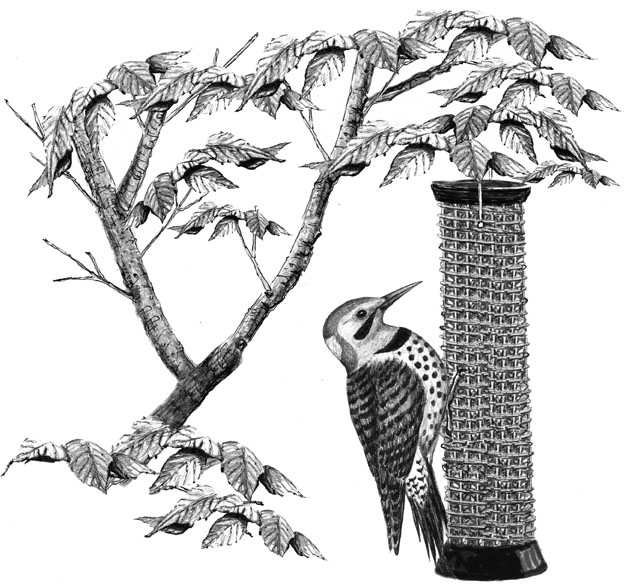
Dear Bird Folks,
We recently took a wonderful birding trip to Cape Cod, which was guided by Mass Audubon’s Wayne Peterson. It was our reward for making the highest bid on Ray Brown’s Talkin’ Birds radio show. Included in this trip was a stop at your store. Knowing we would be meeting you, we decided to wait and ask you this question in person. Each winter we get lots of flickers on our peanut feeder. However, we only see male flickers on the feeder, no females. Any idea why?
– Doug and Lisa, Des Moines, IA
Wow! Doug and Lisa,
You came all the way from Iowa just to go birding on Cape Cod? I have family members who wouldn’t even know that the Cape had birds if I didn’t talk about them so much. And, as part of your trip you were also awarded a visit to my store. Cool! We’ve actually become a prize. I never thought I’d see the day when folks would have to bid just to visit my shop. Wait! That’s a great idea. Instead of standing in front of the shop each morning, smiling and opening the door for people, I’m going to keep the door locked until someone bids high enough to be let in. It’s a whole new twist to retail. I like it.
Most people reading this column are probably aware that Northern Flickers are actually woodpeckers, but without “woodpecker” in their name. I think flickers did that for their own protection. Sometimes woodpeckers get bored with life and drill holes into houses. This upsets people. In order to avoid being found guilty by association, flickers opted not to use woodpecker in their name. It’s a shrewd move on their part.
Actually, the name flicker was given to them because of their diagnostic “flicker, flicker, flicker” call. The Northern Flicker comes in two different flavors, or subspecies as the scientists prefer to say. Here in the East, we have the Yellow-shafted Flicker, a bird with bright yellow under the tail and wings. The West has the Red-shafted Flicker, with red replacing the yellow under the wings and tail. With some other woodpeckers, like our old pal the Downy Woodpecker, the male has a red spot on the back of his head, while the female has none. With Yellow-shafted Flickers, both sexes have the red spot. (The female is not about to be outdone by the male). However, the males, wanting to distinguish themselves from the ladies, have a black moustache growing from the sides of their beaks. This is where the females draw the line. They want no part of growing a moustache. (They know moustaches went out back in the 80s, with Magnum P.I.) The male Red-shafted Flicker also has a moustache, but it’s red, not black. (Apparently, western flickers are of Scottish descent.)
Most of our woodpeckers are fairly stationary birds, but flickers love to migrate. In the summer flickers can be found throughout much of Canada and in Alaska, but the majority of them are long gone by the time the snow starts falling. Another thing that separates flickers from other woodpeckers is that flickers aren’t obsessed with trees. They spend 70% of their feeding time on the ground, searching for ants. Flickers are no fools. Why bother hammering their heads into tree trunks all day, they figure, when they can simply pick juicy ants off the ground? The love of ground feeding may be part of the reason flickers fly south during the winter. It’s tough to find ants when they are buried under four feet of snow. (The exception, of course, is fire ants. Snow just melts when it lands on them.)
In the winter, when insects aren’t as readily available, flickers switch to eating fruit, seeds and nuts. Perhaps this is why you, Doug and Lisa, only see flickers in the winter. Your peanut feeder is the perfect ant substitute. But what you really want to know is why you are only seeing males and no females. That was your question, right? I did quite a bit of research on this subject but couldn’t find a definitive answer. At first, I thought male and female flickers spent the winter apart. In some bird species, the males winter farther north than the females. The males endure the cold in order to be back on the breeding grounds at the first sign of spring. Regrettably, I couldn’t find any evidence that flickers behaved this way. But I have read reports from observers who have seen flocks containing nothing but male flickers. This is weak evidence, but it does suggest that on some occasions male flickers do travel together. It’s possible that in your area male flickers do spend the winter together in a male-only flock. (Either that or your birds have simply joined a lesser-known branch of the Shriners).
With the exception of the giant Pileated Woodpecker, flickers are our largest woodpeckers. But even with their size and powerful beaks, they aren’t able to deal with the smaller, but more aggressive European Starlings. Starlings regularly drive flickers from their nesting cavities and this has caused a sharp decline in their population. Iowa is one of the states that has lost many breeding flickers, so it’s good to know that these handsome birds are still being seen in the winter…thanks, in part, to your peanut feeder.
It was great to meet you, Doug and Lisa. I’m flattered that you traveled all the way from Iowa to visit my shop. I’m sorry I couldn’t provide a more conclusive explanation your flicker question, but maybe if you “bid” a little higher next time, I’ll come up with a better answer for you. I’m just sayin’.